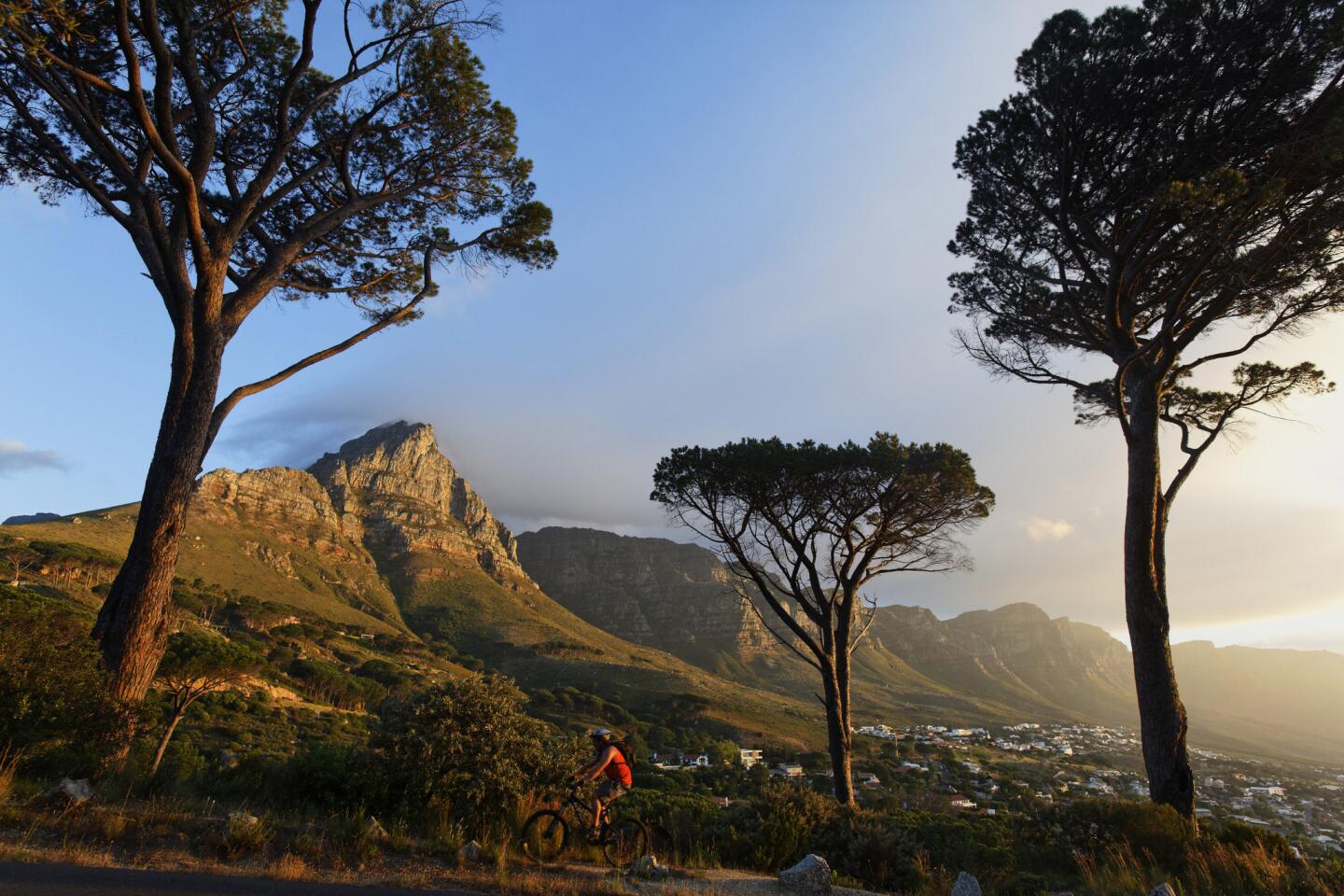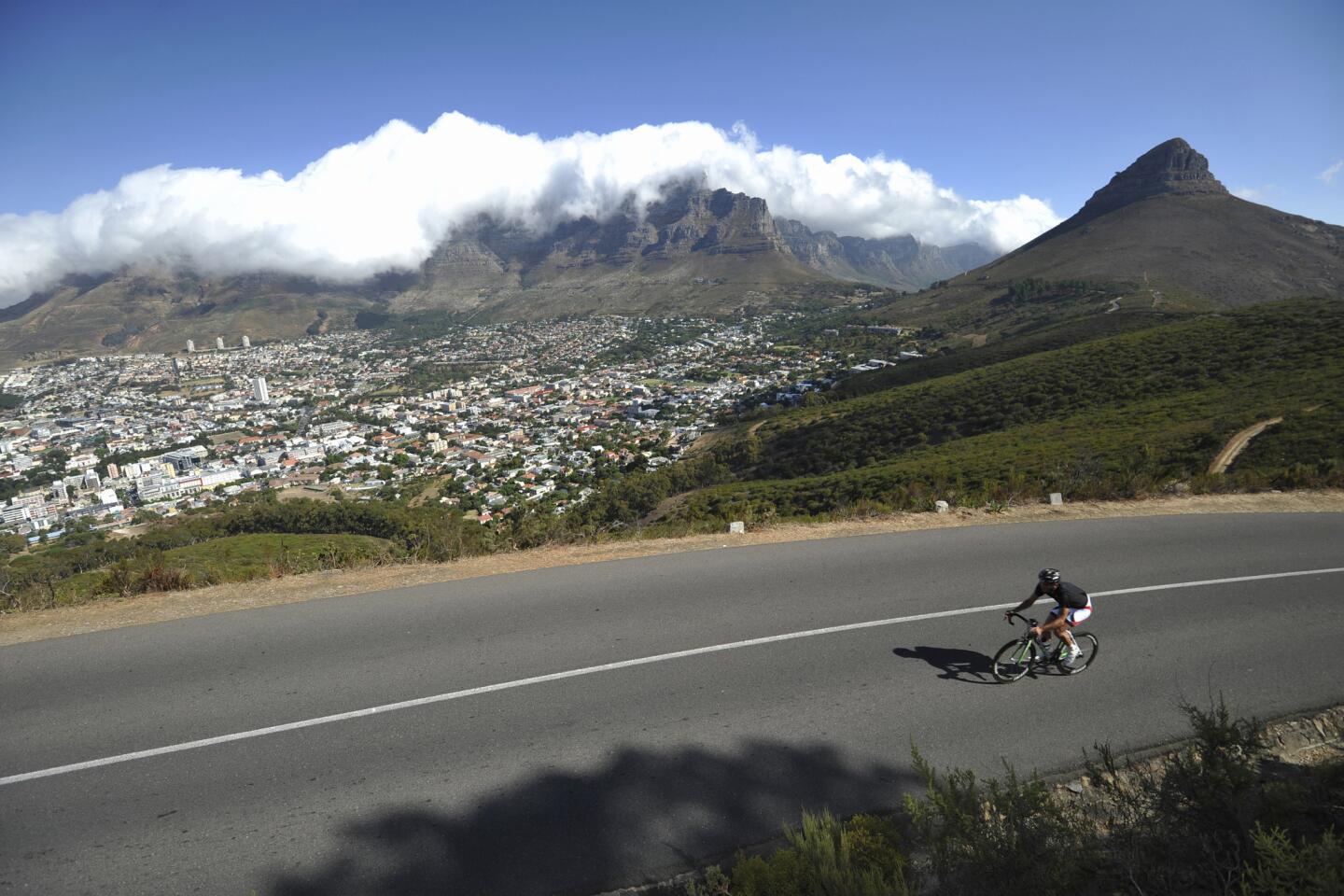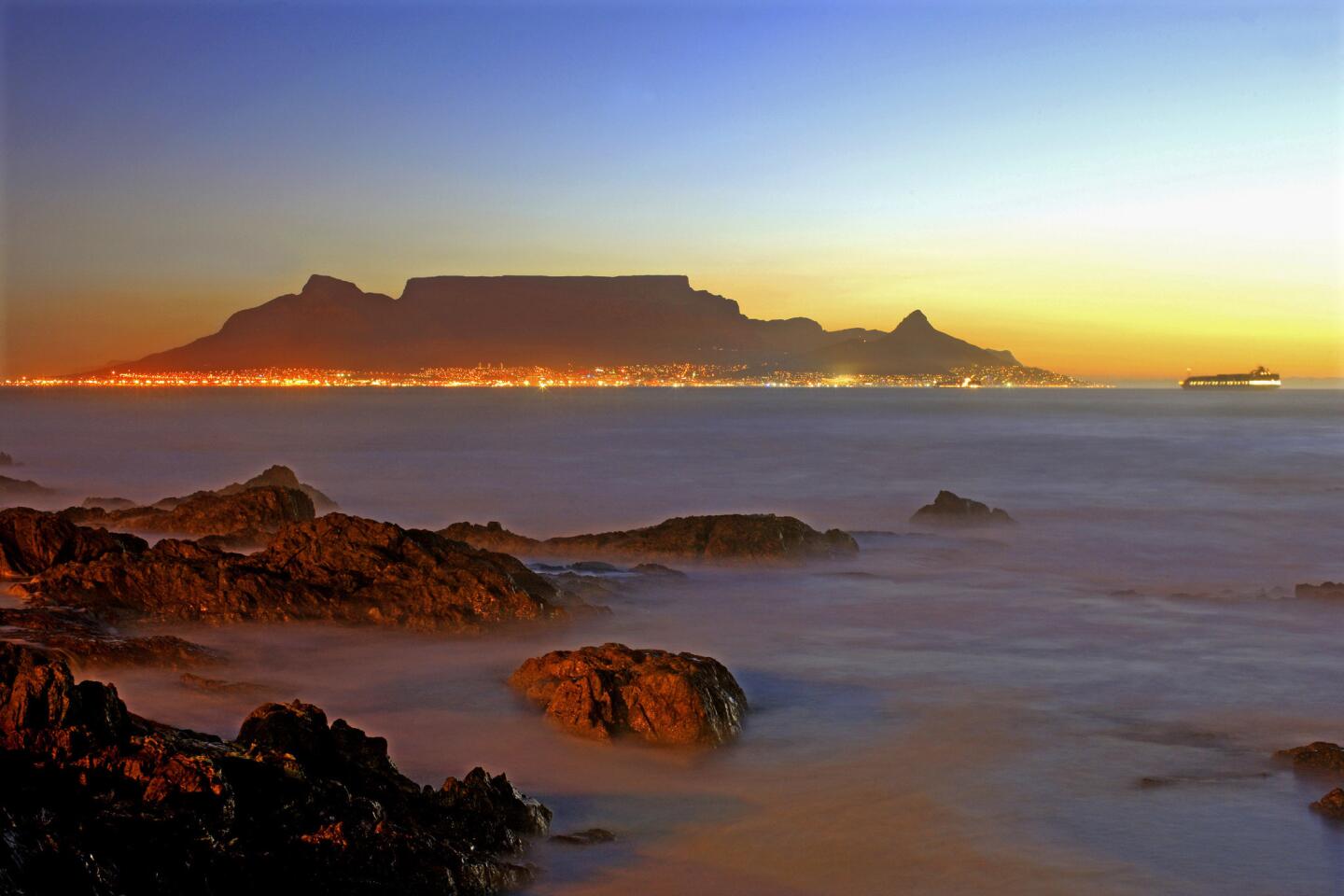A two-wheel tour down Table Mountain and into Cape Town history
- Share via
Reporting from CAPE TOWN, South Africa — “It’s not really technical?” Liz asked Axel Zander, our cycling guide, as he shuttled the four of us to our drop-off point a third of the way up Table Mountain.
“There’s some rocky sections, but I’ll warn you,” said Zander, the founder of Downhill Adventures, who was taking us on the three-hour “double-descent biking adventure” on Cape Town’s most prominent geological feature. “It’s not like downhill extreme stuff, so you can anticipate and move out of the way of any technical sections.”
Aha! I understood why Liz asked. “Technical,” in mountain biking parlance, is often a code word for “dangerous.” When she replied “Good,” I was not only surprised but also starting to wonder what we were getting into.
Cape Town is an adventure capital, which is partly what drew me here, so the bar is pretty high. (Zander’s outfit also offers shark-cage diving and a sand-boarding/skydiving combo.) No matter; it was a sun-drenched September day, with hordes of tourists to prove it.
They were lining up for the cable-car ride to the summit. Zander wasn’t joking when he told us that Table Mountain is the most visited spot in Africa.
Despite the unparalleled vistas, I was glad I was going to cruise on two wheels through the fynbos — South Africa’s answer to our chaparral — rather than be crammed into a moving tin box.
Biking basics
“With mountain biking, the most important thing is anticipating your gear change,” Zander said as he began his briefing. Liz, her husband, Dave, my husband, Chris, and I stood with our 27-speed Giant bikes, torn between ogling the dramatic granite backdrop behind us and catching Zander’s all-important instructions.
“This is especially critical on a trail like this, which is predominantly downhill,” he said. “But there are some sneaky little uphills, and you won’t want to be in your hardest gear as you’re climbing.”
Which brought us to his other most important advice, something that is pure instinct to experienced mountain bikers.
“You need to be sitting down going up a hill,” Zander said. “For descents, on the other hand, stand off your seat, with knees slightly bent but your pedals parallel so your legs and arms actually work as shock absorbers.”
I could see how some people might find all this prepping overkill, but the first drop was steeper than a cow’s face, as the saying goes.
“We don’t want anyone falling off right at the beginning,” Zander said. “Just pick your line and find the concrete to get onto to help stay in control.”
One caveat: Hard-core cyclists hoping for a solid three hours of hammering out single-track will be disappointed. The ride traversed mostly old Jeep tracks, with enough stops that kept me from breaking a sweat. But unless you’re an elite rider, you’ll welcome the breaks to catch your breath and to listen to Zander explain the region’s flora and history.
Post-rain glory
We made our way to the trailhead, biking back along the road we had come in on and reminding ourselves to stay left. The British didn’t just leave behind vestiges of their accent; they also bequeathed their odd driving habit.
“Everybody set?” Zander asked, eyeing us from behind as we proceeded one by one down a relatively short but decidedly vertical drop-off. Though the bikes were equipped with front suspension, they weren’t quite a match for the gravel, ruts and irrigation channels (think speed bumps) that cropped up more frequently than I liked.
All that was forgotten given the expansive views of Cape Town and the close-up glimpses of the area’s flora, bursting in post-rain glory.
“This white flower here is called blombos. If you’re riding in the morning, you’ll notice this musky smell,” Zander said.
“And here’s a different kind of protea,” he said, pointing to a sculptural pinkish bloom known as Common Sugarbush.
We moved on to the next descent, which was a little mellower, though it took some concentration to avoid the puddles from the previous three days of rain.
Soon I was reminded why anticipation is so important: The downhill quickly morphed to a 9% or 10% uphill grade. Good thing I switched into a lower gear. The climb was steep and longer than expected. Dave was out in front, and Chris and Liz were bringing up the rear.
Major landmarks
Once our team finished the uphill, Zander directed our attention to a peak in the distance.
“If you look up, it’s like a profile of the Sphinx. It is abstract, but it’s close enough,” Zander said. “You’ll probably call it more of a baboon.”
He was referring to Lion’s Head, the distinctive rock formation resembling a crouching feline.
The proud beast, named by Dutch settlers in the 17th century, overlooks Cape Town, Table Bay and Robben Island, where Nelson Mandela was imprisoned for nearly two decades.
Next, Zander pointed out another of the area’s major landmarks, Devil’s Peak, named for a Dutch pirate known to head up to the mountain to smoke his pipe. One day the pirate met the devil, who was also sitting there with a pipe.
“They had a contest to see who could smoke the most, and they’re still competing,” Zander said. The tale ties into a phenomenon that occurs each summer when the famed southeaster blows, whipping up a patch of fog that spills over that spot and resembles smoke.
Road to history
Only an hour had passed, but the hardest part of the main ride was over — almost. Once we left the wildness of the trail and headed back to the main road, there was a good half-mile climb, retracing our tracks to the cable car for a restroom and snack break.
From there it was a mostly flat cruise as we wound our way along the paved road until we reached the point where it was closed because of a landslide. That was good news — cars were prohibited — giving us full run of the relatively smooth asphalt. Although the wind kicked up, it only heightened the exhilaration, pushing us around the backside of the mountain where we enjoyed our best glimpses of the harbor area.
“So this gives us a good view to tell the history of Cape Town,” Zander said, pointing out the Castle of Good Hope, a building shaped like a five-point star and built by the Dutch in the 1600s.
The city was founded in 1652 by the Dutch East India Co. as an outpost for resupplying its ships and treating the sick. By the time the British captured what was called Kaapstad in 1795, the population was 14,000.
Today Cape Town’s 3.7-plus-million people include 42% colored (mixed ethnic origin from Europe, Asia and indigenous people), 38% black African, 15% white and less than 2% Asian.
Any history must include the story of District Six, the former inner-city residential area where 60,000 residents were forcibly removed from their homes during the apartheid regime in the 1970s.
“That’s the first part of the land that’s been given back to the original landowners,” said Zander, indicating the infamous neighborhood. “It’s taken 20 years for the first group of original residents to get their houses back.”
One last climb
I wasn’t totally honest when I said the hardest part was over. As we arrived at the turnoff that would lead us to town, Zander reminded us of the optional and most difficult grinder of the 11-mile route — a switchback-filled mount up to the King’s Blockhouse. Dave and I, the oldest members of the group, took on the challenge — a 3/4-mile-long trail that led us to an old fort built by the British as a lookout for ships entering Table Bay. But that wasn’t the only purpose for the structure.
“They’d use cannons, not to shoot but to signal to farmers to bring their produce to meet the ships,” Zander told us.
Now it was all downhill. After reconnecting with Liz and Chris, we descended a slick gravelly track — with a photo stop to capture a hillside of bright pink flowers. This led to what Zander described as “the most dangerous part of the ride, the traffic on the road back to the shop.”
Travel info from Los Angeles to Cape Town, South Africa
THE BEST WAY TO CAPE TOWN, SOUTH AFRICA
From LAX, connecting service (change of planes) to Cape Town is offered on KLM, British, Air France, Virgin Atlantic, Delta and Lufthansa. Restricted round-trip fares from $1,105 to $1,649.
TELEPHONES
To call the numbers below from the U.S., dial 011 (the international dialing code), 27 (the country code for South Africa) and the local number.
WHERE TO STAY
Table Bay Hotel, Victoria & Alfred Waterfront, Quay 6, Cape Town; 21-406-5000, www.suninternational.com/table-bay This “contemporary Victorian” on the waterfront features views of Table Mountain and Robben Island. Doubles from $280.
Cape Town Hollow Boutique Hotel, 88 Queen Victoria St., Cape Town; 21-423-1260, capetownhollow.co.za. Smaller boutique hotel a three-minute walk to Downhill Adventures. A double with mountain views from about $200.
WHERE TO EAT
Chalk & Cork, 51 Kloof St., Cape Town; 21-422-5822, www.chalkandcork.co.za. Just a short walk from Downhill Adventures, the two-story wine bar and restaurant specializes in small plates such as pan-seared angelfish with fennel and grapefruit. The tapas start at less than $2.
Baia Seafood Restaurant, Upstairs at the Victoria Wharf, V&A Waterfront, Cape Town; 21-421-0935, baiarestaurant.co.za. Great views of the harbor and ocean with spectacular food.
BIKING
Downhill Adventures, Shop 1 Oberbeek Building, Orange and Kloof streets, Cape Town; 21-422-0388, www.downhilladventures.com. Table Mountain Double Descent, about $75.
TO LEARN MORE
Cape Town Tourism: www.capetown.travel
South African Tourism: country.southafrica.net
More to Read
Sign up for The Wild
We’ll help you find the best places to hike, bike and run, as well as the perfect silent spots for meditation and yoga.
You may occasionally receive promotional content from the Los Angeles Times.








